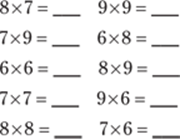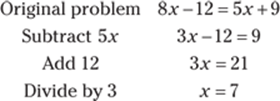Basic Math & Pre-Algebra For Dummies, 2nd Edition (2014)
Part VI. The Part of Tens
 Math is full of important concepts. To discover ten of the most interesting, go to www.dummies.com/extras/basicmathandprealgebra.
Math is full of important concepts. To discover ten of the most interesting, go to www.dummies.com/extras/basicmathandprealgebra.
In this part…
· Discover tricks to help you avoid making common mathematical mistakes
· Expand your understanding of math by learning how to distinguish between different kinds of numbers: natural numbers, integers, rational (and irrational) numbers, algebraic numbers, and more
Chapter 24. Ten Little Math Demons That Trip People Up
In This Chapter
![]() Knowing the multiplication table once and for all
Knowing the multiplication table once and for all
![]() Understanding negative numbers
Understanding negative numbers
![]() Distinguishing factors and multiples
Distinguishing factors and multiples
![]() Working confidently with fractions
Working confidently with fractions
![]() Seeing what algebra is really all about
Seeing what algebra is really all about
The ten little math demons I cover in this chapter plague all sorts of otherwise smart, capable folks like you. The good news is that they're not as big and scary as you may think, and they can be dispelled more easily than you may have dared believe. Here, I present ten common math demons, with a short explanation to set them on a path away from you.
Knowing the Multiplication Table
A sketchy knowledge of multiplication can really hold back an otherwise good math student. Here's a quick quiz: the ten toughest problems from the multiplication table.

Can you do this, 10 for 10, in 20 seconds? If so, you're a multiplication whiz. If not, flip to Chapter 3 and work through my short, sweet, and simple program for nailing the multiplication table once and for all!
Adding and Subtracting Negative Numbers
It's easy to get confused when adding and subtracting negative numbers. To begin, think of adding a number as moving up and subtracting a number as moving down. For example:
·
|
2 + 1 – 6 |
means |
up 2, up 1, down 6 |
So if you go up 2 steps, then up 1 more step, and then down 6 steps, you've gone a total of 3 steps down; therefore, 2 + 1 – 6 = –3.
Here's another example:
·
|
–3 + 8 – 1 |
means |
down 3, up 8, down 1 |
This time, go down 3 steps, then up 8 steps, and then down 1 step, you've gone a total of 4 steps up; therefore, –3 + 8 – 1 = 4.
 You can turn every problem involving negative numbers into an up-and-down example. The way to do this is by combining adjacent signs:
You can turn every problem involving negative numbers into an up-and-down example. The way to do this is by combining adjacent signs:
· Combine a plus and minus as a minus sign.
· Combine two minus signs as a plus sign.
For example:
· –5 + (–3) – (–9)
In this example, you see a plus sign and a minus sign together (between the 5 and the 3), which you can combine as a minus sign. You also see two minus signs (between the 3 and the 9), which you can combine as a plus sign:
·
|
–5 – 3 + 9 |
means |
down 5, down 3, up 9 |
This technique allows you use your up-and-down skills to solve the problem: Down 5 steps, then down 3 steps, and up 9 steps leaves you 1 step up; therefore, –5 + (–3) – (–9) = 1.
See Chapter 4 for more on adding and subtracting negative numbers.
Multiplying and Dividing Negative Numbers
When you multiply or divide a positive number by a negative number (or vice versa), the answer is always negative. For example:
![]()
When you multiply two negative numbers, remember this simple rule: Two negatives always cancel each other out and equal a positive.
![]()
For more on multiplying and dividing negative numbers, see Chapter 4.
Knowing the Difference between Factors and Multiples
Lots of students get factors and multiples confused because they're so similar. Both are related to the concept of divisibility. When you divide one number by another and the answer has no remainder, the first number is divisibleby the second. For example:
![]()
When you know that 12 is divisible by 3, you know two other things as well:
·
|
3 is a factor of 12 |
and |
12 is a multiple of 3 |
In the positive numbers, the factor is always the smaller of the two numbers and the multiple is always the larger.
For more on factors and multiples, see Chapter 8.
Reducing Fractions to Lowest Terms
Math teachers usually request (or force!) their students to use the smallest-possible version of a fraction — that is, to reduce fractions to lowest terms.
To reduce a fraction, divide the numerator (top number) and denominator (bottom number) by a common factor, a number that they're both divisible by. For example, 50 and 100 are both divisible by 10, so
![]()
The resulting fraction, ![]() , can still be further reduced, because both 5 and 10 are divisible by 5:
, can still be further reduced, because both 5 and 10 are divisible by 5:
![]()
When you can no longer make the numerator and denominator smaller by dividing by a common factor, the result is a fraction that's reduced to lowest terms.
See Chapter 9 for more on reducing fractions.
Adding and Subtracting Fractions
Adding and subtracting fractions that have the same denominator is pretty simple: Perform the operation (adding or subtracting) on the two numerators and keep the denominators the same.
![]()
When two fractions have different denominators, you can add or subtract them without finding a common denominator by using cross-multiplication, as shown here:

For more on adding and subtracting fractions, see Chapter 10.
Multiplying and Dividing Fractions
To multiply fractions, multiply their two numerators to get the numerator of the answer, and multiply their two denominators to get the denominator. For example:
![]()
To divide two fractions, turn the problem into multiplication by taking the reciprocal of the second fraction — that is, by flipping it upside-down. For example:
![]()
Now multiply the two resulting fractions:
![]()
For more on multiplying and dividing fractions, see Chapter 10.
Identifying Algebra's Main Goal: Find x
Everything in algebra is, ultimately, for one purpose: Find x (or whatever the variable happens to be). Algebra is really just a bunch of tools to help you do that. In Chapter 21, I give you these tools. Chapter 22 focuses on the goal of finding x. And in Chapter 23, you use algebra to solve word problems that would be much more difficult without algebra to help.
Knowing Algebra's Main Rule: Keep the Equation in Balance
The main idea of algebra is simply that an equation is like a balance scale: Provided that you do the same thing to both sides, the equation stays balanced. For example, consider the following equation:
· 8x – 12 = 5x + 9
To find x, you can do anything to this equation as long as you do it equally to both sides. For example:

Each of these steps is valid. One, however, is more helpful than the others, as you see in the next section.
For more on algebra, see Chapters 21 through 23.
Seeing Algebra's Main Strategy: Isolate x
The best way to find x is to isolate it — that is, get x on one side of the equation with a number on the other side. To do this while keeping the equation balanced requires great cunning and finesse. Here's an example, using the equation from the preceding section:

As you can see, the final step isolates x, giving you the solution: x = 7.
For more on algebra, see Chapters 21 through 23.